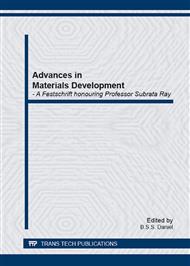[1]
P. Pant, K.W. Schwarz, S.P. Baker, Dislocation interactions in thin films, Acta Mater 51 (2003) 3243-3258.
DOI: 10.1016/s1359-6454(03)00156-3
Google Scholar
[2]
L. Nicola, E. Van der Giessen, A. Needleman, Dislocation interactions in thin films, J. Appl Phys. 93(10) (2003) 5920-5927.
DOI: 10.1063/1.1566471
Google Scholar
[3]
J. Senger, D. Weygand, P. Gumbsch, O. Kraft, Discrete dislocation simulations of the plasticity of micropillars under uniaxial loading, Scripta Mater. 58 (2008) 587-590.
DOI: 10.1016/j.scriptamat.2007.11.031
Google Scholar
[4]
G. Monnet, S. Naamane, B. Devincre, Orowan strengthening at low temperatures in bcc materials studied by dislocation dynamics simulations, Acta Mater. 59 (2011) 451-461.
DOI: 10.1016/j.actamat.2010.09.039
Google Scholar
[5]
M.O. Peach, J.S. Koehler, The Forces Exerted on Dislocations and the Stress Fields Produced by Them, Physical Review 80 (1950) 436-439.
DOI: 10.1103/physrev.80.436
Google Scholar
[6]
L.P. Kubin, Y. Estrin, G. Canova, in: D. Walgraef and N.M. Ghoniem (Eds. ), Patterns, Defects and Material Instabilities, Kluwer Academic, 1990, pp.277-301.
DOI: 10.1007/978-94-009-0593-1_20
Google Scholar
[7]
K.W. Schwarz, Simulation of dislocations on the mesoscopic scale. I. Methods and examples, J. Appl. Phys. 85 (1999) 108-119.
Google Scholar
[8]
H.M. Zbib, M. Rhee, J.P. Hirth, On Plastic Deformation and the Dynamics of 3D dislocations, Int. J. Mech. Sci. 40 (1998) 113-127.
DOI: 10.1016/s0020-7403(97)00043-x
Google Scholar
[9]
S. -W. Lee, S. Aubry, W.D. Nix, Wei Cai, Dislocation junctions and jogs in a free-standing FCC thin film, Modelling and Simulation in Materials Science and Engineering, 19 (2011) 1-13.
DOI: 10.1088/0965-0393/19/2/025002
Google Scholar
[10]
A.K. Head, Phil. Mag., 44 (1953) 92-93.
Google Scholar
[11]
A. Hartmaier, M.C. Fivel, G. R. Canova, P. Gumbsch, Image stresses in a free-standing thin film, Modelling and Simulation in Materials Science and Engineering, 7 (1999) 7781-793.
DOI: 10.1088/0965-0393/7/5/310
Google Scholar
[12]
D. Weygand, M. Poignant, P. Gumbsch, O. Kraft, Three-dimensional dislocation dynamics simulation of the influence of sample size on the stress-strain behavior of fcc single-crystalline pillars, Mater. Sci. Engg. A 188 (2008) 483-484.
DOI: 10.1016/j.msea.2006.09.183
Google Scholar
[13]
S.P. Baker, A. Kretschmann, and E. Arzt, Thermomechanical Behavior of Different Texture Components in Cu Thin Films, Acta Materialia 49 (2001) 2145-2160.
DOI: 10.1016/s1359-6454(01)00127-6
Google Scholar
[14]
B. D. T. Hoc, L. Kubin, Dislocation mean free paths and strain hardening of crystals, Science, 320 (2008), 1745–1748.
DOI: 10.1126/science.1156101
Google Scholar
[15]
B. Devincre, T. Hoc, L. P. Kubin, Collinear interactions of dislocations and slip systems, Materials Science and Engineering A, 400-401 (2005), 182–185.
DOI: 10.1016/j.msea.2005.02.071
Google Scholar
[16]
A. Vattre, B. Devincre, A. Roos, Orientation dependence of plastic deformation in nickel-based single crystal superalloys: Discrete continuous model simulations, 58 (2010), 1938–(1951).
DOI: 10.1016/j.actamat.2009.11.037
Google Scholar
[17]
S.K. Sahoo, V.D. Hiwarkar, I. Samajdar, G.K. Dey, D. Srivastav, R. Tiwari, S. Banerjee, Heterogeneous deformation in single-phase zircaloy 2, Scripta Mater 56 (2007), 963 – 966.
DOI: 10.1016/j.scriptamat.2007.02.008
Google Scholar
[18]
V. V. Bulatov and W. Cai, Computer Simulations of Dislocations. Oxford University Press, (2006).
Google Scholar
[19]
W. Cai, A. Arsenlis, R. C.R. Weinberger, V.V. Bulatov, A non-singular continuum theory of dislocations, Journal of the Mechanics and Physics of Solids, 54 (2006), 561–587.
DOI: 10.1016/j.jmps.2005.09.005
Google Scholar
[20]
G. Monnet, B. Devincre, L.P. Kubin, Dislocation study of prismatic slip systems and their interactions in hexagonal close packed metals: Application to zirconium, 52 (2004), 4317–4328.
DOI: 10.1016/j.actamat.2004.05.048
Google Scholar


